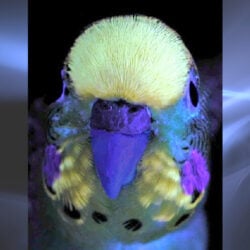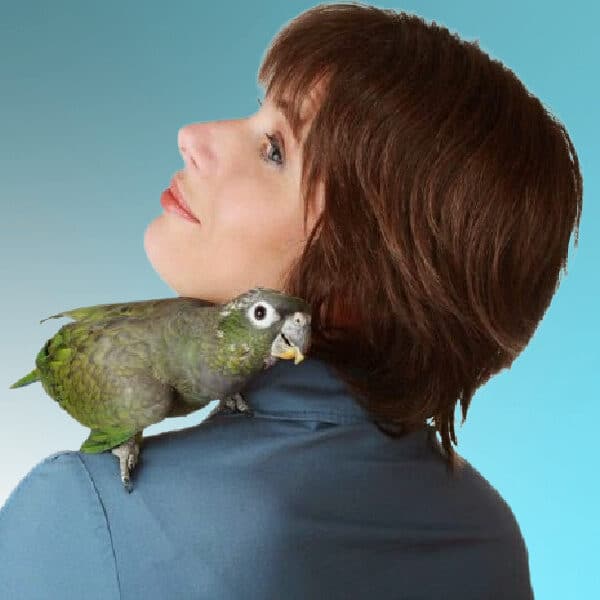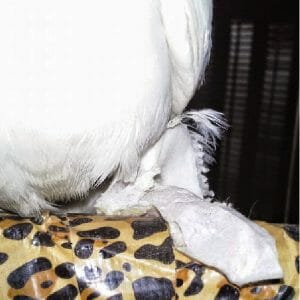Last Updated on by Mitch Rezman
I received a phone call from a woman with a 15-year-old Blue Front Amazon.
He was in the original cage he had come home in 15 years ago.
The cage needed replacing and she was seeking a residential model.
Because he didn’t like being in the (24″ x 24″ brass) bird cage he had his own room.
In the room was his own futon.
He perched on top of the futon where he’d been whittling down the wood for a while and spent a lot of time under the futon on a blanket.
He was also fond of chewing the wallboard in the room.
She went on to relate, “We let him out at the same time every morning.
I leave pretty early so and he has breakfast with my husband.
When it’s time for my husband to go to work, Arnold (the Amazon) gets put back in his room where he seems quite content to be on or under the futon curled up in a blanket until I get home from work.
My husband puts him in the cage when we go to bed at night, but Arnold won’t let me do it”.
Big picture, the birdcage is a tad small for a bird that size. The good news is that the bird spent most of the time on or under the futon in his own bedroom – more about the futon in a bit.
Bad news, Arnold’s likely a girl.
It’s clear Arnold is exhibiting brooding behavior.
The curling up under the futon AND the chewing of the wallboard were all the clues I needed to figure that out.
The wallboard has calcium, the stuff that’s in cuttlebones.
Unfortunately, wallboard also contains toxins and things like glass to hold it all together so it’s not a good choice as a calcium supplement.
The blanket made great nesting material.
Feathered factoid: Back in the day when wallboard (drywall) wasn’t tainted and didn’t contain things like sulfur and strands of glass, farmers would feed crumbled wall board to their chickens as a calcium supplement.
Another problem that came to mind was the fixed daily routine.
In our unscientific observations, we see Amazons being a “one person” bird.
Because hubby was doing the daily feeding, I asked if she could think of reasons she had issues handling the bird and her husband did not.
“He – she doesn’t like me very much – especially lately.”
I asked if anything had changed in the household recently.
“Actually my husband’s been homesick for the past couple of weeks.”
What jumped to mind was this excellent blog post from Lara Joseph Question on behavior . . .
A bird showing sudden signs of aggression after a change in routine.
A sentence she wrote really brings this issue into focus,
“I try not to keep the birds on many routines because if that routine is broken, I begin to see undesired behavior issues begin to develop”
Our caller had a smartphone so I shot that link right off to her.
Then I went on to explain, the bird’s point of view and we ask people to put themselves (mentally) in the SAME birdcage (room of the house) for 15 years.
Things can get awfully boring for your bird which may be prompting the additional negative behavior Arnold was exhibiting towards her.
There’s a reason cable TV offers a gazillion channels – we like variety.
Birds need variety to be good mental too. Change is good for birds. Actually, as a best practice, we recommend taking everything out of your bird’s cage at least once a month and re-installing all the cage perches, feeder dishes, and bird toys in new locations in the birdcage.
This not only challenges the bird mentally but causes them to use their bodies and especially their feet in different ways, important for good bird foot health.
(If you’re doing things right, this is a good size project but will pay off in the long run for your bird’s psychological well-being.
Some people will look at their cage with the original dowel perch that came with the cage and a couple of toys and say “no problem.”
How I teach our new 7 yo Senegal that change is essential for your bird to accept it ~ Video
We recommend at least 3 types of perches and no less than 10 toys in your parrot’s cage.
A well-stimulated bird that feels secure, is a happy bird. – but I digress).
Regarding a new birdcage we recommended a larger play top style birdcage giving Arnold a more natural place to be on the cage when out of the cage, a higher point in the room too.
To go along with the new cage we recommended a bird play stand. Something light and portable so when Arnold came out of her room, she’d have a place of her own to perch, anywhere in the house.
How would Arnold react?
I guess probably not well initially. But what Arnold doesn’t realize is, in the long run.
She’ll feel better about herself in a new bigger home. Just like any of us would.
We suggested putting the futon in the trash and introduce a bed inside the new larger birdcage.
A place she could feel secure AND safe. Arnold would probably adapt to the new cage in just a few days. Most birds do.
Here’s the thing.
It seems as though many of us are driven to keep our birds on a daily routine with minimal change as possible.The problem is when that routine changes it can and probably will impact the behavior of your bird.
If you get up every morning at 8 AM open up the cage, pour yourself a cup of coffee while going through the newspaper (remember those?), your bird will certainly enjoy the routine.
The question is what happens when you have an appointment or an obligation that causes your bird to be locked up for a few additional hours in the morning or the rest of the day for that matter.
The change in routine can trigger anything from screaming to plucking to simply acting out with weird behavior.
You’re not doing your bird any favors by not exposing them to anything new in terms of their immediate environment or their daily schedule.
What was the last time you took everything out of your bird’s cage and put it back in and all new places?
It’s been a while, hasn’t it?
You’re afraid you’ll upset your little pooky bird.
The issue of the cage and routine change goes beyond behavior problems.
Some of you read about how our Cockatiel Popcorn’s foot ended up in a cast this past February. the reason I’m bringing this up to this discussion is it required us to modify the cage layout to discourage climbing.
This is a bird who usually sees three birdcages a day – home – travel – work.
She also lives in a veritable toy store and office so when we see something we think would be really cool for a cockatiel, we stuff it into one of her cages.
That said, ask yourself something. How would your bird react if it left home with its cage looking like this and by the time you got back home after being traumatized by the terrible Dr. Ellen AND your foot looked like a stupid duck’s foot, your cage looked like this.
Popcorn’s only reaction was the thought they should serve a snack at the vet’s office – because, for her, every day is a little different.
Written by Mitch Rezman
Approved by Catherine Tobsing
Approved by Catherine Tobsing
Author Profile
Latest entries
 Bird BehaviorJune 13, 2025Why Do Some Parrots Struggle in Captivity?
Bird BehaviorJune 13, 2025Why Do Some Parrots Struggle in Captivity? Bird & Parrot AnatomyJune 12, 2025Why are Budgerigars Called The Colorful Parrots?
Bird & Parrot AnatomyJune 12, 2025Why are Budgerigars Called The Colorful Parrots? Bird & Parrot AnatomyJune 12, 2025How Do Monk Parakeets Talk to Each Other?
Bird & Parrot AnatomyJune 12, 2025How Do Monk Parakeets Talk to Each Other?  Bird BehaviorJune 10, 2025How Cockatoos Learned to Use Drinking Fountains Like People
Bird BehaviorJune 10, 2025How Cockatoos Learned to Use Drinking Fountains Like People




